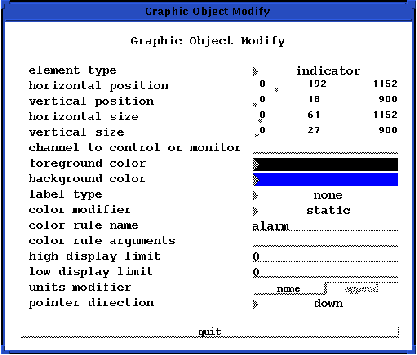Chapter 4 Creating and Manipulating Objects
10. Property Sheets
The only options left in the Modify menu (refer back to Figure 4-3) are the modify channel names, move and resize options, but because you can move and resize objects by changing certain values in their property sheets and because you generally enter channel names in an object's property sheet, we will first discuss property sheets before we discuss these three options.
To bring up an object's property sheet:
- 1. Select the object or objects.
- 2. Choose modify from the Modify menu.
All property sheets, regardless of which type of object they belong to, have the first five options that you see in Figure 4-18: (1) element type, (2) horizontal position, (3) vertical position, (4) horizontal size, and (5)vertical size. Except for graphics objects, all property sheets have the properties for 'foreground and background color'. Objects in the graphics subclass only have one property that determines their color.
Below you will find a brief definition for these seven properties.
- Element type
- This property tells which type of object the object is. Note the triangular marker to the left, indicating that it is a menu-entry line. If you hold down the right mouse button while the property is highlighted, a quite lengthy menu with all the types of objects will appear. You can change the object's type simply by choosing another type of object in this menu.
- Horizontal Position
- This property is a slider that has the object's current position along the X axis in the drawing area. The object's left edge determines its position on the X axis. You can change an object's size by holding down the left mouse button and dragging the mouse either left or right to decrease or increase the slider's value. The range of the slider is 0 to 1,152.
- Vertical Position
- This property is the same as the property above, except that its slider has the value for the object's position along the Y axis in the drawing area. You can change the object's position in the drawing area by changing the value of the slider. The range of its values is 0 to 900.
- Horizontal Size
- This property is a slider that has the object's current horizontal size as its value. The object's horizontal size is the width between the object's left and right edges. You can change the object's width by changing the slider's value. The range of its values is 0 to 1,152.
- Vertical Size
- This property is the same as the 'horizontal size' property, except that its slider has the value for the object's vertical size. The vertical size is the height between the object's top and bottom edges. You can change the height by changing the slider's value. Its range is 0 to 900.
- Foreground Color
- This property has a color bar that shows the object's current foreground color. For objects from the monitors, controllers, or plots groups, the foreground color property determines the object's outline, any text or numbers within the object, and all dynamic values at run-time. For objects from the graphics subclass, this color is the same as its color property, as they have no background color property. You can change the object's color to any color in the color table by holding down the right mouse button while this property is highlighted and choosing the desired color from the menu that appears.
- Background Color
- This object has a color bar that shows the object's current background color. Remember that lines, arcs and text objects in the graphics group, do not have this property. The background color for all objects in the monitors, controllers, and plots groups is simply everything within its borders that is not text or numbers. The background color is the static part of a dynamic object.
EDD/DM User's Manual, 2.4 - 27 MARCH 1997 [Next] [Previous] [Up] [Top] [Contents] [Index]
